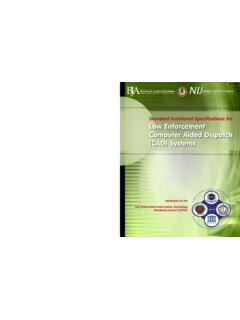Transcription of COMPSTAT - Bureau of Justice Assistance
1 COMPSTAT :ITS ORIGINS, EVOLUTION, AND FUTURE IN LAW ENFORCEMENT AGENCIESB ureau of Justice AssistancePolice Executive Research ForumBureau of Justice Department of JusticeCOMPSTAT:ITS ORIGINS, EVOLUTION, AND FUTURE IN LAW ENFORCEMENT AGENCIESB ureau of Justice AssistancePolice Executive Research ForumCopyright 2013 by Police Executive Research Forum, Washington, DC 20036 All rights points of view expressed herein are the authors and do not necessarily represent the opinions of the Bureau of Justice Assistance or individual Police Executive Research Forum in the United States of AmericaISBN: 978-1-934485-23-1 Cover and text page design by Dave : Its Origins, Evolution, and Future In Law Enforcement AgenciesiiiACKNOWLEDGMENTS ..vFOREWORD ..viiINTRODUCTION ..1 WHAT IS COMPSTAT AND HOW DID IT DEVELOP?
2 2 What Is COMPSTAT ? ..2 COMPSTAT Emerges at NYPD ..3 COMPSTAT Is Adopted by Other Law Enforcement Agencies ..6 COMPSTAT Is Adopted by Non-Law Enforcement Agencies ..6 WHAT DO WE KNOW ABOUT COMPSTAT TODAY?..8 The Case for COMPSTAT ..8 COMPSTAT Must Be a Clear, Purposeful Strategy ..8 COMPSTAT Is More Than a Meeting ..9 COMPSTAT Is Flexible and Can Accelerate Organizational Change ..9 Organizational Change in Three Agencies: Chicago; Clearwater, FL; and Camden, NJ ..12 COMPSTAT Increases Accountability ..14 Follow-Up Is Critical ..15 COMPSTAT Empowers Officers, but Chiefs Should Anticipate Initial Resistance ..15 COMPSTAT Meetings Should Be Direct but Respectful ..16 Information-Sharing Supports COMPSTAT Wins Support of Officers, Community Members in Daytona Beach, Florida ..20 COMPSTAT Depends on Effective Crime Analysis.
3 21 Ensuring the Accuracy of Crime COMPSTAT Inhibit Decentralization of Decision-Making? ..23 COMPSTAT Can Be Applied to Resource Management as well as to Crime Reduction ..24 THE FUTURE OF COMPSTAT ..26 CONCLUSION ..30 REFERENCES ..32 APPENDIx A: PERF COMPSTAT ExECUTIVE SESSION PARTICIPANTS ..34 APPENDIx B: PERF SURVEY AND SURVEY RESULTS ..36 TABLE OF CONTENTSC ompstat: Its Origins, Evolution, and Future In Law Enforcement AgenciesvThe Police Executive Research Forum (PERF) would like to thank the Bureau of Justice Assis-tance (BJA) for supporting this examination of the impact of COMPSTAT on police performance and accountability. We are grateful to BJA Direc-tor Denise O Donnell and former Acting Director James Burch for recognizing the importance of identifying how COMPSTAT and other data-driven performance measurement systems have evolved and how they can be best used by police agencies in the 21st Century.
4 Our program manager, BJA Senior Policy Advisor Michael Medaris, was sup-portive and enthusiastic throughout the project, and we are grateful to BJA Associate Deputy Di-rector Pam Cammarata for her wisdom, support, and guidance. We would also like to thank the law enforce-ment agencies that participated in our survey on the use of COMPSTAT and data-driven management tools. Their insights guided our subsequent re-search and site visits. We are especially indebted to Chief Ellen Hanson, Lenexa Police Department (KS), Commissioner Frederick Bealefeld, Balti-more Police Department (MD), and Chief Theron Bowman, Arlington Police Department (TX) who assisted us with the pilot testing of our We appreciate the police chiefs, scholars, and other professionals who attended our Executive Session titled COMPSTAT : Today and Tomorrow in Baltimore in March 2011 (see Appendix A for a full list of attendees).
5 Many of those in attendance provided a detailed look into their agencies suc-cesses and challenges with COMPSTAT or a similar performance management system. Dr. Robert D. Behn shared his work at the Harvard Kennedy 1 The titles listed throughout this document reflect officials positions at the time of the 2011 Executive of Government. Dr. James Willis, George Mason University, and Dr. Brenda Bond, Suffolk University, provided us with insight into what the research tells us about COMPSTAT . For a perspec-tive on the origins of COMPSTAT in the New York City Police Department (NYPD), we appreciate the contributions of former Commissioner Wil-liam Bratton, former Chief of Department Louis Anemone, former Chief of Department and First Deputy Commissioner John Timoney, current Deputy Commissioner Mike Farrell, Dr.
6 George Kelling of Rutgers University, and Dr. Dennis Smith of New York the course of the project, a number of police agencies across the country opened their doors to us. We are especially grateful to be able to share their experiences and best practices in this publication. Our visits generally included attend-ing a COMPSTAT meeting, followed by interviews with the chief executive, members of the com-mand staff, crime analysts, and others integral to the success of the organization s performance management systems. We would like to thank the police chiefs and all those who contributed to our visits at their agency: Colonel James Teare, Anne Arundel county Police Department (MD); Chief Theron Bowman, Arlington Police Department (TX); Commissioner Frederick Bealefeld, Balti-more Police Department (MD); Chief James John-son, Baltimore county Police Department (MD); Superintendent Garry McCarthy, Chicago Police Department (IL); Chief Michael Chitwood, Day-tona Beach Police Department (FL); Chief Kim Dine, Frederick Police Department (MD); Colonel Rick Rappoport, Fairfax county Police Depart-ment (VA); Chief Charlie Beck, Los angeles Police Department (CA); Colonel Terrence Sheridan, Maryland State Police.
7 Chief Ed Flynn, Milwaukee ACKNOWLEDGMENTSC ompstat: Its Origins, Evolution, and Future In Law Enforcement Agenciesvi(TX); Deputy Commissioner Michael Farrell, New York Police Department; Former Acting Chief Jeff Godown, San Francisco Police Department; Dr. Rachel Boba, Florida Atlantic University; and Beth Blaur, who directs Maryland s statewide perfor-mance management , credit is due to PERF staff members who helped write and edit this report, including Craig Fischer, David Green, Jerry Murphy, and Molly Griswold. Police Department (WI); Chief Thomas Manger, Montgomery county Police Department (MD); Chief Jane Castor, Tampa Police Department (FL); and Commissioner Charles Gardner and Commis-sioner Edmund Hartnett, Yonkers Police Depart-ment (NY). We also thank the following individuals who discussed their experiences with us: Chief Anthony Holloway, Clearwater Police Depart-ment (FL); Chief David Brown and Deputy Chief Randall Blankenbaker, Dallas Police Department COMPSTAT : Its Origins, Evolution, and Future In Law Enforcement AgenciesviiCompstat helps to achieve that mission.
8 Essen-tially, a COMPSTAT program requires police to gather timely, accurate information about crime patterns, and then respond quickly to break up those patterns. COMPSTAT holds many advantages for a law en-forcement chief executive who is trying to build an effective agency that enjoys the respect of the com-munity. COMPSTAT fosters accountability by hold-ing commanders and other individuals responsible for knowing the details about the crime in their districts and for devising plans to reduce crime levels. COMPSTAT encourages information shar-ing within a police department as well as between police and other agencies that can help eliminate conditions that contribute to crime. Information about COMPSTAT also can be shared with the public in different ways. COMPSTAT established the pivotal role of crime analysis in policing.
9 In fact, this key principle of COMPSTAT gathering and analyzing data to pro-duce solutions is so universal, it has been ad-opted by other government agencies that have no connection to policing. BJA and PERF are pleased to have had this op-portunity to produce this report, which describes how COMPSTAT came about, how it has evolved, and where it stands to go in the future. BJA and PERF have a longstanding relationship and a shared interest in promoting innovations and promising practices in policing, and COMPSTAT is one of the best of those 20 years ago, COMPSTAT has now become the norm in most major police departments. And in a profession that has seen programs come and go, COMPSTAT has withstood changes in adminis-trations. Today COMPSTAT is a part of the institu-tional DNA of policing. Why is that? It s because COMPSTAT gives police chiefs a daily report on how their departments are performing.
10 We have advanced from a time when police departments worked with crime data that was six or twelve months old to an age of real-time crime data. Crime trends are quickly identified and actions taken to prevent further crime and and BJA came together to look at how COMPSTAT has evolved over these years. Law en-forcement agencies have taken COMPSTAT in dif-ferent directions and to new levels of performance since it was first developed by the New York City Police Department in the early should come as no surprise that COMPSTAT was invented in a local police department. All of the big new ideas in modern American policing originated at the local level. Community policing, problem-oriented policing, hot spots policing, the Broken Windows theory, predictive analytics all these innovations reflect the homegrown genius of law enforcement no policing innovation developed by a local agency has been more transformative than COMPSTAT .



















